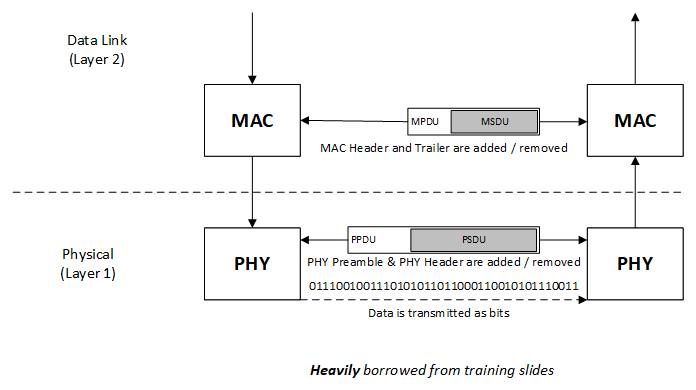It is time to quit referring to the PLCP PDU / PMD interface. Here is why.
In August of 2012, the IEEE published a document called “Delete the PMD (Comment Resolution for D3.0).” It was authored by Eldad Perahia, Brian Hart, and Adrian Stephens. Within the 18 pages of this document are the revisions deleting the PLCP / PMD interface and replacing it with, PHY.
They say, “This submission resolves two CIDs and general confusion about the PLCP/PMD split by effectively deleting the PLCP/PMD interface. The rationale is that this is a completely imaginary and useless interface and there are no devices that split their PHY in such a manner.” 1 This document redefined the PPDU from PLCP PDU to PHY PDU. This was done to keep the acronym the same to avoid further confusion. The document also left intact the changes that they proposed. See figure 1.

This makes sense to replace the PLCP/PMD Interface as the OSI model has never referred to “Sublayers” of Layer 1. In the ISO document, “Information Technology – Open Systems Interconnection – Basic Reference Model: The Basic Model – 1996,” Section 7.7, PLCP / PMD Interface is not mentioned. It does refer to the PSDU as a Physical Service Data Unit.
The deletion of the PMD and revision of the PPDU also happened on the 802.11ad, WiGig, amendment in July 2013.2
In 2016, the IEEE defines the PPDU as, “physical layer (PHY) protocol data unit (PPDU): The unit of data exchanged between two peer PHY entities to provide the PHY data service.” Notice the first “P” is now “PHY” and not “PLCP.” A search of the 3534 pages reveal 0 instances of either “PLCP” or “PMD.”
In fact, Perahia appears to not favor the upper and lower layers of the MAC Layer, but that is for another day.
The IEEE 802.3-2016 gives the definition of a PPDU as “(PHY) protocol data unit.”3 The term “PMD” is not listed in the definitions.
I understand that we have all been taught that the PMD is responsible for putting bits on the PHY. Perahia explained in 2012 that the PMD really only contained “things such as RSSI/RCPI measurements.”4

The CWNP textbook for the CWAP-403 exam talks of the PHY and MAC sublayer in the beginning of Chapter 3. It references the 802.11-2016 standard in which the PHY layer has no sublayers. But it then quickly refers again to the PHY PLCP sublayer making for confusing reading. I am no expert by any means in the 802.11-2016 standard. But I am a rules loving kind of guy. And our rule book says the PLCP/PMD Interface no longer exists. I implore all text book writers to quit referring to PMD or PLCP Protocol Data Unit as it just isn’t correct anymore.
The CWNP textbook for the CWAP-403 exam talks of the PHY and MAC sublayer in the beginning of Chapter 3. It references the 802.11-2016 standard in which the PHY layer has no sublayers. But it then quickly refers again to the PHY PLCP sublayer making for confusing reading. I am no expert by any means in the 802.11-2016 standard. But I am a rules loving kind of guy. And our rule book says the PLCP/PMD Interface no longer exists. I implore all text book writers to quit referring to PMD or PLCP Protocol Data Unit as it just isn’t correct anymore.
By the way, the above binary code converted to ASCII says, “rules.”
1 https://mentor.ieee.org/802.11/dcn/12/11-12-1009-03-00ac-delete-pmd.docx
2 https://mentor.ieee.org/802.11/dcn/13/11-13-0867-00-000m-delete-pmd-from-11ad.docx
3 https://ieeexplore.ieee.org/document/7786995/definitions#definitions
